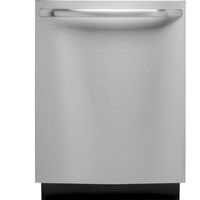Ge Dishwasher Not Cleaning. GE dishwashers are known to run quietly and simply with a variety of efficient, durable design options.
Understanding that GE dishwashers have been known to face common issues as they age, it may help to repair one if it isn’t cleaning dishes properly.
To fix this problem, it is advised that you clear your appliance’s spray arm and remove food particles clogging the holes.
One might also check their water inlet valve for any damages caused by debris or clogging and then clean their dishwasher filter. These few simple steps can ensure GE dishwashers run efficiently once again.
Ge Dishwasher Not Cleaning
We discuss some problems with the Ge dishwasher when it does not clean.

Filter Issue With Dirt
Previously dishwashers would often have a self-cleaning filter which is was located under the rack and sort of resembles a grater that would grind down all the leftover food particles until they were small enough to wash away.
So it’s most likely newer models will not come with this feature. Instead, a removable filter is probably present.
Which needs to be taken out, cleaned, and wiped with a damp cloth from time to time in order for your dishwasher to function at its best.
Problems Related To Detergents
Bad quality or improper detergent can affect how clean your dishes turn out it can leave a residue. Using too much detergent can also cause problems, so don’t overdo it.
Be sure you’re using the right kind of product and the right amount; use them sparingly to watch your dishwashing results go up.
Use a rinse agent to finish the job off and remove any possible stickiness since hard water will otherwise make things really sticky.
Finally, load the dishwasher correctly putting in too many dishes may be hard on both the machine and they are harder to wash, while few dishes make for better-looking spots-free stuff.
Problems With The Circulation Pump
Water is forced up through hoses by a motor and impeller in the circulation pump. A defective circulation pump will prevent the dishwasher from washing dishes properly.
Ensure that the power is on in your home before checking if the problem is with the motor. Once the dishwasher is turned on, run a cycle.
Verify that the rotation of the pump or its noise after running a cycle of water indicates that checked well for debris as necessary before replacing them. Be aware that this can be challenging because it can take some skill to do so.
Faulty Wash Impeller
In order for water to flow through the wash arms, the wash impeller forces it up with a thin plastic blade.
It may not be able to generate enough pressure to force the water up the arms if the impeller is broken or has lost some of its fins.
It is possible to replace the wash impeller independently from the pump and motor assembly on most models. You can find out if your impeller can be replaced by searching for your model number.
If however, you find it’s not possible to replace your washer’s impeller without swapping out both pump and motor assembly.
Assemblies For Pump And Motor
Water is forced up through the wash arms by the impeller being spun by the motor. Dishes will not be properly cleaned if the motor is defective, the pump impeller is broken, or some part of the pump is clogged.
Make sure the circulation pump and motor assembly are powered. Replace the pump and motor assembly if power is getting to the pump and motor assembly but it still does not run.
Water With A Low Temperature
Although the average dishwasher cycle requires water that is at least 120 degrees to function properly.
Some models have internal mechanisms which will automatically turn the dishwasher off if it detects that the temperature drops too low.
If your model doesn’t have this feature, make sure that your water heater is set to 120 degrees and run a faucet in your kitchen for thirty seconds before starting a cycle as this will cause hot water to enter the machine at the very beginning instead of solely drawing from cold water in later stages of the cycle.
Spray Arm Clogged
Under and/or above the dishwasher trays, there are several spray arms that seem to spin. It is supposed to allow for a more thorough cleaning, but the jets in these arms become clogged over time resulting in reduced water pressure.
Cleaning the spray arms may improve performance. If your model permits, you can take off the arms for cleaning by snapping them off easily; however some models require you to remove a screw first.
If so, unscrew and then clean them with a soft brush, dish soap, toothpicks, etc. before rinsing everything under hot water again.
Related Guides

